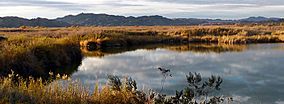Imperial National Wildlife Refuge facts for kids
Quick facts for kids Imperial National Wildlife Refuge |
|
|---|---|
 |
|
| Location | Imperial County, California, La Paz County, Arizona, and Yuma County, Arizona, United States |
| Nearest city | Yuma, Arizona |
| Area | 25,768 acres (104 km2) |
| Established | 1941 |
| Governing body | U.S. Fish and Wildlife Service |
| Website | Imperial National Wildlife Refuge |
The Imperial National Wildlife Refuge is a special place that protects animals and their homes. It stretches along about 30 miles (48 km) of the lower Colorado River in Arizona and California. This area includes the last part of the river that flows naturally before it reaches Mexico.
Inside the refuge, there's also a protected wilderness area called the Imperial Refuge Wilderness. This wild space covers about 15,056 acres (60.93 km²). It's a great spot for many outdoor activities. You can go boating, hiking, fishing, and camping here. People also enjoy exploring old mining camps and watching for wildlife.
The Colorado River, with its quiet lakes and wet areas, creates a green oasis. This green space stands out against the dry desert mountains around it. It's a safe haven and a breeding ground for birds that travel long distances and for animals that live in the desert.
Contents
Amazing Animals of the Refuge
Even though the Imperial National Wildlife Refuge is in the Sonoran Desert, it's mostly a wetland environment. This means it has lots of water, which is perfect for many types of animals. The most animals can be seen in winter. During this time, birds like cinnamon teal and northern pintail visit the refuge.
In the summer, animals that live here all year are easy to spot. For example, you'll see many great egrets. The Colorado River is super important for desert animals. It's the only water source for miles around. Small animals like the black-tailed jackrabbit and western whiptail lizard are common. You might also see Desert bighorn sheep and mule deer living here.
Birds of the Imperial Refuge
The refuge is a birdwatcher's paradise! Many different kinds of birds live here or stop by during their travels. Here are some of the birds you might find:
- Common loon
- Western grebe
- Blue-footed booby
- Brown booby
- American white pelican
- Brown pelican
- Double-crested cormorant
- Great blue heron
- Great egret
- Snowy egret
- Wood stork
- Canada goose
- Wood duck
- Mallard
- Northern pintail
- Cinnamon teal
- Turkey vulture
- Osprey
- Bald eagle
- Red-tailed hawk
- American kestrel
- Peregrine falcon
- Gambel's quail
- Sandhill crane
- Killdeer
- California gull
- Common tern
- Mourning dove
- Common ground-dove
- Yellow-billed cuckoo
- Greater roadrunner
- Barn owl
- Great horned owl
- Burrowing owl
- White-throated swift
- Hummingbird
- Belted kingfisher
- Gila woodpecker
- Tree swallow
- Barn swallow
- Woodhouse's scrub jay
- Common raven
- Brown creeper
- Cactus wren
- Marsh wren
- Northern mockingbird
- House finch
You can find a complete list of all the birds at the refuge on their official website.
A Forest in the Desert
Long ago, the banks of the Colorado River were covered with forests. These forests had tall cottonwood and willow trees. They grew strong because the river would naturally flood sometimes, giving them water. Animals relied on these green forests for places to breed, rest, find food, and get shade.
Over time, these forests have faced many challenges. People cut down trees for steamboats and to clear land for farming. Wildfires also destroyed parts of the forest. New plants, like salt cedar, took over. Also, building dams to stop floods changed the river's flow. This has greatly harmed the cottonwood and willow trees along the lower Colorado River. Some animals, like the southwestern willow flycatcher, which depended on these riverside forests, are now endangered.
Exploring the Refuge Trails
The Imperial National Wildlife Refuge offers a fun trail for visitors. The Painted Desert Trail is a 1.3-mile (2.1 km) path. It's a self-guided trail, meaning you can explore it at your own pace.
This trail is a great way to see different desert plants and animals. As you walk, you'll notice a rainbow of colors in the rocks. These colors were made by volcanic activity that happened 30,000 years ago! The trail also gives you an amazing view of the Colorado River valley.
Images for kids


